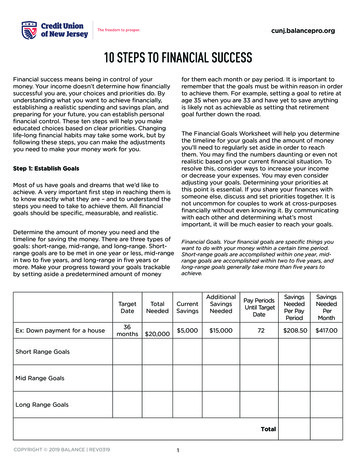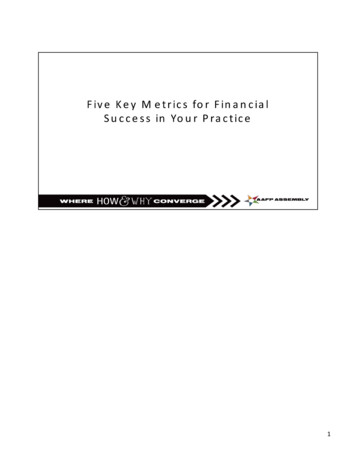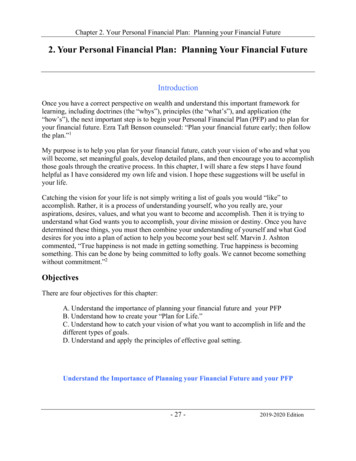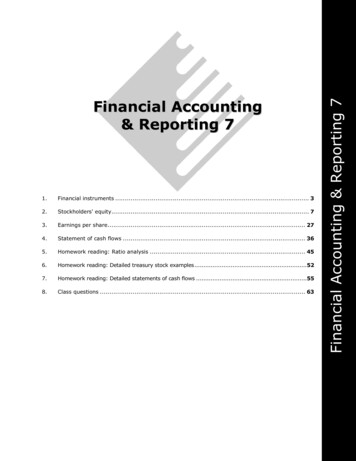
Transcription
cunj.balancepro.org10 STEPS TO FINANCIAL SUCCESSFinancial success means being in control of yourmoney. Your income doesn’t determine how financiallysuccessful you are, your choices and priorities do. Byunderstanding what you want to achieve financially,establishing a realistic spending and savings plan, andpreparing for your future, you can establish personalfinancial control. These ten steps will help you makeeducated choices based on clear priorities. Changinglife-long financial habits may take some work, but byfollowing these steps, you can make the adjustmentsyou need to make your money work for you.for them each month or pay period. It is important toremember that the goals must be within reason in orderto achieve them. For example, setting a goal to retire atage 35 when you are 33 and have yet to save anythingis likely not as achievable as setting that retirementgoal further down the road.The Financial Goals Worksheet will help you determinethe timeline for your goals and the amount of moneyyou’ll need to regularly set aside in order to reachthem. You may find the numbers daunting or even notrealistic based on your current financial situation. Toresolve this, consider ways to increase your incomeor decrease your expenses. You may even consideradjusting your goals. Determining your priorities atthis point is essential. If you share your finances withsomeone else, discuss and set priorities together. It isnot uncommon for couples to work at cross-purposesfinancially without even knowing it. By communicatingwith each other and determining what’s mostimportant, it will be much easier to reach your goals.Step 1: Establish GoalsMost of us have goals and dreams that we’d like toachieve. A very important first step in reaching them isto know exactly what they are – and to understand thesteps you need to take to achieve them. All financialgoals should be specific, measurable, and realistic.Determine the amount of money you need and thetimeline for saving the money. There are three types ofgoals: short-range, mid-range, and long-range. Shortrange goals are to be met in one year or less, mid-rangein two to five years, and long-range in five years ormore. Make your progress toward your goals trackableby setting aside a predetermined amount of moneyEx: Down payment for a houseTargetDateTotalNeeded36months 20,000Financial Goals. Your financial goals are specific things youwant to do with your money within a certain time period.Short-range goals are accomplished within one year, midrange goals are accomplished within two to five years, andlong-range goals generally take more than five years toachieve.CurrentSavingsAdditionalSavingsNeeded 5,000 15,000Pay PeriodsUntil TargetDateSavingsNeededPer PayPeriodSavingsNeededPerMonth72 208.50 417.00Short Range GoalsMid Range GoalsLong Range GoalsTotalCOPYRIGHT 2019 BALANCE REV03191
cunj.balancepro.orgStep 2: Take StockIn order to evaluate your progress as you work toward your goals, you must determine what your overall financialpicture looks like today. Your net worth is simply the difference between what you own and what you owe. Tomake sure you are staying on track, calculate your assets and liabilities at least annually. If you conscientiouslyfollow your plan, you should see a gradual, steady increase in your net worth. Complete the Net Worth Worksheetto see where you currently stand.What You OwnWhat You tsCredit cardsStocks & BondsCredit cardsIRAs/Employersponsored retirement plansAuto loan(s)Other loan(s)Home/real estate Other loan(s)Automobile(s)Other debt(s)Other assetsTOTAL OWED (B)TOTAL OWNED(A)To figure your net worth, subtract the total owed from the total owned.Total owned (A) – Total owed (B) (Net worth)Step 3: Create a Spending and Savings PlanNow that you know what you want to achieve financially and what your net worth is, it’s time to take a close lookat the reality of your day-to-day financial situation. You know where you want your money to take you, but it’salso important to know where you are right now.IncomeThe first step in examining your spending plan is to look at your income. How do your gross and net incomecompare? Are your tax withholdings appropriate for you? If you get a large tax refund or owe taxes each year, youmay want to make some withholding adjustments. Use the Income Worksheet to write down how much you make.Be realistic when it comes to any non-guaranteed income such as overtime and bonuses. Also, if your incomefluctuates, use a conservative figure to make sure you don’t overestimate.COPYRIGHT 2019 BALANCE REV03192
cunj.balancepro.orgMonthly Income. Enter your gross (pre-tax) and net (post-tax) income from all sources. For income that youreceive infrequently (such as bonuses or tax returns) calculate the annual income, then divide by twelve to findthe monthly amount.SourceGrossNetJobSpouse’s jobPart-time jobRental/room & board receivedCommissions/bonusesTax refundsInvestment incomeGovernment benefitsUnemployment insuranceChild support/alimonySupport from family/friendsOtherTotalExpensesAnalyzing expenses by developing a detailed budget can be a challenge, especially if you have never done itbefore. However, if you think of it as establishing a plan for spending and a tool for reaching your financial goals,it becomes a much more pleasant concept.Use the Weekly Expense Worksheet and Monthly Expense Worksheet to list your expenses. You may need totrack your daily spending for several weeks or months to get a realistic cash flow picture. Consider listing everyitem you buy in notebook, or save receipts and tally them up at the end of the day. Another option is to use yourdebit card for all or most of your purchases and refer to the statement that your financial institution provides forspending information. After you have accurate figures, plug the numbers into the worksheets. If more money isgoing out than coming in, consider all reasonable options to at least come out even. Perhaps you can increaseyour income with a part-time job, car pool to save on gas, or bring your own lunch to work.Be aware of “budget busters.” These vary from person to person, but often include impulse purchases, splurgingon gifts or vacations, and the mysterious way the 40 you took out of the ATM is suddenly gone.COPYRIGHT 2019 BALANCE REV03193
WEEKLY EXPENSE yBudgetExpensesOver ionBabysittingPersonal careClothingBank OtherOtherWeekly TotalsBudget Overview:IncomeExpenses4Balance ( /-)COPYRIGHT 2019 BALANCEOther
MONTHLY EXPENSE WORKSHEETItemWeek 1Week 2Week 3Week 4Week 5TotalMonthlyExpensesMonthlyBudgetOver sportationBabysittingPersonal careClothingBank OtherMonthly TotalsBudget Overview:IncomeExpenses5Balance ( /-)COPYRIGHT 2019 BALANCEOther
cunj.balancepro.orgSavingsSaving money is an important, but often neglected, part of every financial plan. Even with the best intentions,there always seems to be a reason to put off getting started until next month. The only way to reach your financialgoals, however, is to start setting aside the money now. Before allocating cash for your goals, make sure you setup an emergency savings account. Financial emergencies are a fact of life and can drain your dream fund if you’renot prepared. Having three to six months’ worth of basic living expenses set aside in a liquid account can protectyou if the unexpected happens. In tougher economic times, you may want to save six to nine months worth ofexpenses to be safe. Set a target date for having this safety net in place, and include the monthly amount neededto get there into your spending plan.Once you have the emergency savings in place, you can factor in the amount you want to save toward the goalsyou determined in Step One.DebtIf you are holding on to unsecured debt, make repayment a priority. It makes sense to rapidly eliminate highinterest balances before you save for a luxury vacation or dream home. Use the Unsecured Debt Worksheet to listyour creditors and add your balances. By knowing what you owe, you’ll be better prepared to commit the fundsnecessary to tackle that obstacle.Unsecured Debt. List all debts (except auto loans and mortgages) along with the name of the creditor, interest rate, totalbalance owing, and the required minimum payment. This includes credit and charge cards, installment loans, personal loans,and outstanding medical bills.Unsecured Debt WorksheetCreditor NameInterest RateMonthly PaymentBalance12345678910Add your expenses, the amount you need to save to reach your goals, and the payments to your creditors.Subtract the total from your income. If the numbers balance, congratulations – you’re on the right track. If not,you will need to take action, which could mean increasing income, decreasing expenses, adjusting your goals, or acombination of these activities.COPYRIGHT 2019 BALANCE REV03196
cunj.balancepro.orgBottom Line. Once you have determined the total of your take-home pay and expenses, you are ready to figure out your bottomline. Using the Bottom Line Worksheet, subtract the total of all expenses including debt payments from your net income. If theresult is a positive number, you can add the extra money to your savings to reach your goals sooner. If your expenses exceedyour income, you’ll need to make some adjustments to bring your finances back into balance.Bottom Line WorksheetMonthly NetIncomeTotalDiscretionaryExpensesTotal EssentialExpenses––Total DebtPayment–Balance Step 4: Live Within Your MeansLiving within your means may seem like simple common sense. All you need to do is spend less than you make,right? For many of us, though, the reality is much more challenging than this basic concept. If your expensesexceed your income, you charge more each month than you pay off, or you’re not saving toward your goals, youare, in fact, living beyond your means – and cheating yourself out of making the most of your money. Don’t getdiscouraged, though. There are ways to gain control of your finances.You may have a few options for increasing your income. Working overtime, getting a part-time job, a betterpaying job, or applying for a promotion are a few possible ways to bring in more money. Selling assets can bringin lump sums that can be used for eliminating debt or applying to savings plans for future goals. If you decide toliquidate assets, though, be sure to find out if you will have any tax consequences or penalties for doing so.Most of us have some expenses we can reduce or eliminate. While fixed living expenses are generally moredifficult to adjust than discretionary expenses, if you are truly committed to your goals, a little creativity can go along way. Consider each expense carefully. Is there anything you currently spend money on that you can reduce,substitute, postpone, or forego?Budget GuidelinesHousingSpend no more than 35% of net income on housing. Depending on whether you rent orown, that can include mortgage/rent, utilities, insurance, taxes, and home maintenance.SavingsSave at least 10% of income throughout your working life. Make sure you have 3–6months income in an emergency fund before you start saving for other goals.TransportationSpend no more than 15% of net income on transportation. That includes a car payment,auto insurance, tag or license, maintenance, gasoline, and parking.DebtSpend no more than 15% of net income on such consumer debt as student loans, retailinstallment contracts, credit cards, personal loans, tax debts, and medical debts.OtherSpend no more than 25% of net income on all other expenses. This includes food, clothing, entertainment, childcare, medicalexpenses, tithing/charity, and vacations.COPYRIGHT 2019 BALANCE REV03197
cunj.balancepro.orgStep 5: Pay Yourself FirstLong-term savings plans are the third tier. For mostpeople, long-term savings are for retirement or a child’scollege education. Because you have many years tosave, investment earnings can make your money workfor you. There are several savings plans available forthese goals with favorable tax advantages.There never seems to be a convenient time to startsaving – the car breaks down, you have to buy holidaygifts, a larger than expected utility bill comes in .However, because of the power of compound interest,continuingly making even small investments in yourfuture can result in saving a small fortune over time.That’s why the most frequently given advice byfinancial planners is to pay yourself first. In other words,make savings your top priority.The chart shows the difference between a 250 amonth contribution to a tax-deferred account and ataxable account, assuming a 6% annual return and stateand federal marginal tax rate of 30%.The easiest, most painless way to save money isthrough an automatic savings plan. Talk to youremployer about having a set amount deducted fromyour paycheck and deposited into a savings accountbefore you even see it. Another option is to have yourfinancial institution move a set sum from your checkingaccount to a savings account on a designated day eachmonth.Tax Deferred vs. Taxed InvestmentsTax Deferred 300,000 250,000 200,000An excellent goal to shoot for is to save ten percentof your net income. This can seem like an intimidatingfigure, but if you prioritize your spending, you mayvery well be able to meet it. By weighing the instantgratification you feel by making some of your currentfinancial choices against the ultimate reward ofreaching your goals, you may find that you are ableto save much more than you ever thought you could.Establishing a three-tiered savings plan allows youto protect yourself against the inevitable financialsurprises that come your way while working towardyour future financial dreams. 150,000 100,000 50,000015 years20 years25 years30 yearsEmployer-sponsored Retirement PlansIf you work for a for-profit company you may have a401(k) plan available to you, and if you work for a nonprofit organization, a charity, or a school you may havea 403(b) plan available to you. Both plans allow you tosave for your retirement using tax-deferred funds. Youdon’t pay taxes on the amount you contribute or onthe investment earnings in your plan account until youwithdraw funds, usually when you retire. As an addedincentive to save, your employer may even match aportion of your contributions – which is essentially freemoney for you.The first tier is an emergency savings that should equaltwo to six months of your essential expenses. Thiswill provide you a safety cushion should you becomeunemployed or suffer some other financial setback.Keep these funds in an account where there are nopenalties for early withdrawal. So you aren’t temptedto dip into it for something other than emergencies,don’t save the money in a checking account, but use aseparate savings account instead. If you have any otherimportant goals that you want to save for in twelvemonths or fewer, include them in this first tier as well.Individual Retirement AccountsIRAs are personal accounts set up for retirementplanning. For traditional IRAs, contributions are limitedto a specific dollar amount, and are completely taxdeductible as long as you don’t participate in anemployer-sponsored retirement plan. If either you oryour spouse participate in an employer-sponsored plan,your IRA deduction may be limited or eliminated basedon your income.The next tier of savings is for your medium termgoals- the ones you want to reach in two to five years.It is a good idea to keep these funds in a semi-liquidinvestment account – one where the interest you earnoutpaces inflation. Avoid investing the money in anaccount that puts your savings at great risk. If themarket is down when you are ready to take the fundsout, you won’t have enough for your goals.COPYRIGHT 2019 BALANCE REV0319Taxed8
cunj.balancepro.orgRoth IRALike a traditional IRA, the Roth IRA is set up forpersonal retirement planning. While Roth IRAcontributions are non-deductible, the earningsaccumulate tax-deferred and may be withdrawn taxfree if you’ve had the Roth IRA for more than fiveyears and you are at least 59.5 years old. There is a tenpercent penalty for withdrawals made before you are59.5, however, this penalty may be waived for qualifiedhigher education expenses, first-time home purchases,disability, death, and certain medical expenses.soon as you do, your deposits will reap the benefit ofcompound interest. In order to save money, you mayhave to spend a little less today, but your future, andthat of your family, is probably worth the sacrifice.This chart reflects a savings plan of 150a month with a 6% annual return.Harness the Power of Time 200,000Coverdell Education Savings AccountsPreviously called Educational IRAs, Coverdell EducationSavings Accounts are tax-deferred accounts. Thecontributions are not tax deductible, but they dogrow tax-free, and the funds can be withdrawn taxfree as long as they are used to pay eligible schoolingcosts. Most people can use the Coverdell, thoughif your adjusted gross income is high, the amountyou can contribute is limited or phased out entirely.You can open a Coverdell at any financial institutionthat handles traditional IRAs, and you may use justabout any investment option to build your savings,including stocks, bonds, mutual funds, and certificatesof deposits. The money in the account must be usedbefore the child reaches 30. If your child decides notto attend college or there is an unused portion leftover, there will be a tax consequence and ten percentpenalty. To avoid this, you can roll over the balance toanother Coverdell plan for a different family member. 150,000 100,000 50,000015 years20 years25 years30 yearsStep 6: Delete Your DebtIf consumer debt is throwing your budget out of whack,discipline and commitment are the keys to get it backon track. First, make a pact with yourself to live a cashonly lifestyle. Before you can reduce your balances, youneed to stop increasing them. Close the accounts if youdon’t feel you can control your spending. If you keep anemergency credit card, don’t carry it with you. Keep itin a secure place in your home.529 Plans529 plans allow you to save for your child’s highereducation expenses while greatly reducing your taxliability. As long as the investment is used for qualifiededucation expenses, you won’t have to pay income taxon the earnings, and if you use your own state’s planyou may also qualify for a state tax deduction. Thereare two varieties of 529 plans: the college savingsplan and the prepaid tuition program. With a collegesavings plan, the plan manager provides a selection ofinvestments from which you are able to choose. Prepaidtuition programs are really a way to lock in tomorrow’stuition costs at today’s prices. Contributions are limitedto amounts necessary to pay your child’s educationexpenses at a specific institution. The program managermakes the investment decisions for you, ensuring thereis enough accumulated for the tuition.There are two basic methods of efficiently repayingyour debt. Increasing your payments will dramaticallyreduce the length of time, and thus the cost, of payingyour creditors. Reducing interest rates will also saveyou repayment time and money. If your credit rating isgood, requesting better rates from your lenders maywork.Transferring balances to lower rate accounts is alsoeffective. If you have equity in your home, convertinghigh-interest credit card debt to low-interest secureddebt is a tool to consider- and the intere
Oct 10, 2020 · Be aware of “budget busters.” These vary from person to person, but often include impulse purchases, splurging on gifts or vacations, and the mysterious way the 40 you took out of the ATM is suddenly gone. . Financial emergencies are a fact of life and can drain your dream fu











